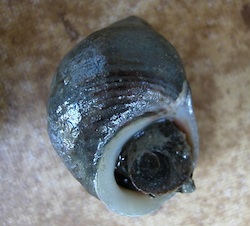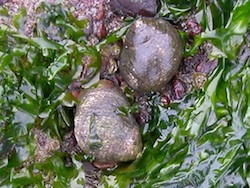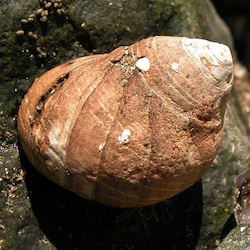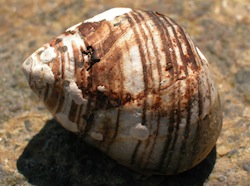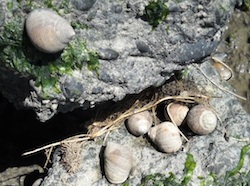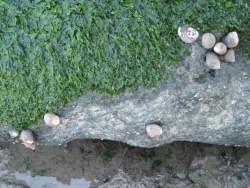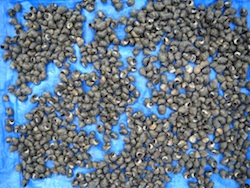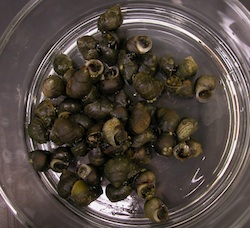Littorina littorea (Linnaeus, 1758)
COMMON PERIWINKLE
- Kingdom: Animalia
- Phylum: Mollusca
- Class: Gastropoda
- Order: Neotaenioglossa
- Family: Littorinidae
Littorina littorea is a European periwinkle that has become established in eastern North America. Though it has been found on the Pacific Coast on several occasions ranging from discoveries of single individuals to populations of several thousand snails, most of these have died out (sometimes assisted by eradication efforts), and it is not yet known to be established. Littorina littorea often occurs in the seaweed used to pack shipments of New England bait worms and lobsters, and is also sold as live seafood in Asian food markets in California.
Littorina littorea grows to around 38 mm in height, and has a thick brown, gray-brown or blackish shell with 5-8 whorls. The shell profile is smoothly conical, with no obvious shoulders where one whorl attaches to the preceding one. Younger snails have fine spiral ridges on the whorls and a sharp apex; on older snails the ridges are usually worn smooth and the apex rounded or eroded. The inner edge or lip of the aperture is thick and usually white, and the tentacles are marked by transverse black bands.
In the Atlantic, Littorina littorea is found on both open coast and estuary habitats from the upper intertidal zone to about 40 meters deep, and can tolerate salinities down to around 13 ppt. Though most abundant on rocky substrates and common in tidepools, it is a habitat generalist that also occurs on muddy or sandy bottoms. In favorable habitats, it reaches densities of up to 200-800 individuals per square meter. It grazes on a wide variety of algae, especially small, ephemeral species including diatoms, Enteromorpha, Ulva and Porphyra. It also feeds on small newly settled barnacles and other invertebrates.
Since its arrival in North America, Littorina littorea has become the most abundant shallow-water herbivorous snail from Nova Scotia to Long Island Sound (Bertness 1984). It is reported to have displaced some native snails, depress the growth of others, and consume the eggs of others. It has greatly altered New England intertidal communities by allowing slower growing algae to dominate over the faster growing algal species that it prefers (Lubchenco 1978). In a series of experiments, Bertness (1984) found that Littorina littorea bulldozes sediment from hard substrate and prevents sediment accumulation and the development of an algal canopy, and consumes the shoots and rhizomes of the marsh cordgrass Spartina alterniflora. Bertness described the possibility of a positive feedback process, in which predominantly soft-bottom habitats are colonized by Littorina littorea, which reduce sediment cover and expose hard substrates, leading to greater recruitment of Littorina littorea (which prefer hard substrate) thereby increasing the rate of sediment loss; and he suggested that the snail's invasion had reduced the extent of soft-bottom and saltmarsh habitats in northeastern North America. Reviewing the history of coastal invasions, Carlton (1992) concluded that “no introduced marine mollusk in North America has had a greater ecological impact” than Littorina littorea, which “altered the diversity, abundance, and distribution, of many animal and plant species on rocky as well as soft bottom shores.”
A mature female Littorina littorea produces 10,000-100,000 eggs a year. These are released in 1 mm wide, gelatinous, floating egg capsules, each containing usually 2-3 eggs, but sometimes up to 9 eggs. After a few days the eggs hatch into veliger larvae that escape the capsules and spend 2-6 weeks in the plankton. Littorina littorea reaches maturity in 2-3 year at a size of 10-12 mm, and lives up to 5-10 years. Predators include a variety of shore birds, fish, crabs and lobsters. Littorina littorea are commercially harvested in Europe, especially in Scotland and Ireland, and in North America in New Brunswick and Nova Scotia, primarily in the Bay of Fundy.
Similar Species
There are several Littorina species on the Pacific Coast, none of which grow as large as Littorina littorea. The largest is Littorina keenae, which ranges from Coos Bay, Oregon to Baja California. It is found on bare rock in the high intertidal zone on the open coast and into San Francisco Bay at least as far as the western shore of Yerba Buena Island. It grows up to 23 mm high, and is distinguished from Littorina littorea by a white stripe on the inside of its shell and by a conspicuous smooth, flattened area on the inner edge or lip of the aperture.
Littorina plena and Littorina scutulata grow to only 18-19 mm high, have mainly dark or black shells, often with a checkered pattern, with a black or purple-black operculum and a dark or black inner edge on the aperture, and have a narrower profile than Littorina littorea. Both species range from Alaska to Baja California.
An Atlantic species, Littorina saxatilis, is established at several locations within San Francisco Bay. Shell heights up to 12 mm have been recorded in San Francisco Bay, and up to 18 mm in the Atlantic Ocean. It has conspicuous shoulders where one whorl attaches to the preceding one (unlike in Littorina littorea), strong spiral ridges on the shell surface, and is commonly yellow, or yellow on the lowest whorl and gray or brown on the upper ones, with occasional white or dark brown shells.
Littorina subrotunda is found from Alaska to Humboldt Bay, grows up to 12 mm high, and is highly variable in shell shape, surface texture and color (including black, white, orange and banded forms). It is primarily found in salt marshes and in the high intertidal zone on wave-exposed rocky shores; it is rarely found on protected rocky shores. Littorina sitkana ranges from Alaska to Cape Arago, Oregon. It grows up to 21 mm high, and is similarly variable in shape, surface texture and color, but with a thicker shell, and is commonly found on protected rocky shores.
Native Range
From northern Spain to Great Britain, Scandinavia and the White Sea in Russia.
Introduction and Distribution on the Pacific Coast [with dates of first record]
Littorina littorea has been collected many times on the Pacific Coast but does not yet appear to be established at any site. Collections include the following:
- British Columbia: Vancouver [first collected in 2010]: Over 350 collected. Live Littorina littorea are sold at seafood markets in the area
- Washington: Deception Pass [first collected in 1937]: 12 live and 4 dead collected in 1937, 6 live and 2 dead collected in 1949. No further records at this site.
- California: Trinidad Bay [first collected in 1942]: Unknown number collected in 1942. No further records at this site.
- California: San Francisco Bay [first collected in 1968]: Various collections of small numbers (1 collected at Berkeley in 1968 and another in 2003, 6 collected at Selby in 1976-77, 1 collected at Hunter’s Point in 1995, 1 collected at Coast Guard Island in 2001, 1 collected at Oakland in 2004, 1 collected on the breakwater at the Alameda Naval Air station in 2010) probably arrived in discarded seaweed used to pack marine baitworms from Maine. Somewhat larger groups (13 collected from southern Alameda Island and at the bridge between Alameda and Bay Farm islands in 1968-70; 17 collected at Foster City in 2007-09) might be due to either baitworm seaweed or to an intentional release of snails sold as seafood. Larger collections (≈160 at Ashby Spit (Point Emery) in 2007-10; many thousands collected at Dumbarton Point between 2002 and 2011) seem likely to be due to intentional releases of seafood snails rather than discarding of baitworm seaweed. This is discussed further below.
- California: Newport Beach [first collected in 1966]: 1 collected in 1966, no further records at this site.
- California: Anaheim Bay [first collected in 2002]: 30-40 snails collected in Nov 2002; almost 2,300 counted in May 2004; 1,828 removed in August 2004. Probably due to an intentional release of seafood snails.
Genetic evidence suggests that San Francisco Bay (Dumbarton Point and Ashby Spit) and Anaheim Bay Littorina littorea arrived from eastern North America rather than Europe (Chang et al. 2011). This is consistent with introduction of these populations by either the bait trade or the live seafood trade.
In the late 1990s we found Littorina littorea to be very common in the seaweed (Ascophyllum nodosum) used to pack shipments of baitworms (pileworms and bloodworms) from Maine that were received by bait shops near San Francisco Bay, and we estimated that at that time over 10,000 Littorina littorea were being discarded into the bay with this seaweed each year (Cohen et al. 2001). The importing of baitworms from Maine appears to have started in the San Francisco Bay area in the 1960s, and in southern California possibly as early as the 1950s. We suspect that most of the collections of small numbers of Littorina littorea in these areas were due to this trade.
Another possibility is transport in the Ascophyllum nodosum used to pack shipments of live lobsters from New England, though the relatively small amount of such seaweed that could end up in Pacific coastal waters suggests that this is a much less likely mechanism. However, Littorina littorea from the Canadian Maritimes or possibly New England are also sold as live seafood in markets in California and British Columbia, and can also be ordered online and shipped directly to consumers (Cohen 2012). Quantities of snails from these markets could be released by individuals seeking to establish populations for future harvest. We think this is the likeliest explanation for the large populations (thousands of snails) found at Seal Beach in Southern California, at Dumbarton Point and possibly other sites in San Francisco Bay, and at Vancouver in British Columbia. We have seen live Littorea littorea for sale in markets near San Francisco Bay since the 1990s, but don’t know when this trade began.
Since Littorina littorea produce larvae that spend 2-6 weeks drifting in the plankton, transport in ballast water from either eastern North America or Europe is also possible though less likely.
Additional Global Distribution [with dates of first record]
In eastern North America from Nova Scotia to Virginia. Whether Littorina littorea is native to eastern North America has been debated in numerous papers since the late 1800s, but recent work makes a compelling case that Littorina littorea invaded North America in the late 1700s or early 1800s, traveling from the United Kingdom or Ireland to Nova Scotia, probably in rocks used as ballast (Blakeslee & Byers 2008; Brawley et al. 2009).
Literature Sources and Additional Information
Bertness, M.D. 1984. Habitat and community modification by an introduced herbivorous snail. Ecology 65(2): 370-381.
Blakeslee, A.M.H. and J.E. Byers. 2008. Using parasites to inform ecological history: comparisons among three congeneric marine snails. Ecology 89: 1068-1078.
Brawley, S.H., J.A. Coyer, A.M.H. Blakeslee, G. Hoarau, L.E. Johnson, J.E. Byers, W.T. Stam and J.L. Olsen 2009. Historical invasions of the intertidal zone of Atlantic North America associated with distinctive patterns of trade and emigration. Proceedings of the National Academy of Sciences 106(20): 8239-8244.
Carlton, J.T. 1992. Introduced marine and estuarine mollusks of North America: an end-of-the-20th-century perspective. Journal of Shellfish Research 11(2): 489-505.
Chang, A.L., A.M.H. Blakeslee, A.W. Miller and G.M. Ruiz. 2011. Establishment failure in biological invasions: a case history of Littorina littorea in California, USA. PLoS One 6(1): 1-11.
Cohen, A.N. 2012. Live Marine Seafood and the Introduction of Non-native Species into California. A report for the California Ocean Science Trust, Oakland, CA and the California Ocean Protection Council, Sacramento, CA. Center for Research on Aquatic Bioinvasions, Richmond, CA.
Cohen, A.N. and J.T. Carlton. 1995. Nonindigenous Aquatic Species in a United States Estuary: A Case Study of the Biological Invasions of the San Francisco Bay and Delta. U.S. Fish and Wildlife Service, Washington, DC (p. 53).
Cohen, A.N., A. Weinstein, M. A. Emmett, W. Lau and J.T. Carlton. 2001. Investigations into the Introduction of Non-indigenous Marine Organisms via the Cross-Continental Trade in Marine Baitworms. A report for the U.S. Fish and Wildlife Service, San Francisco Bay Program, Sacramento CA. San Francisco Estuary Institute, Richmond CA.
Lubchenco, J. 1978. Plant species diversity in a marine intertidal community: importance of herbivore food preference and algal competitive abilities. American Naturalist 112(983): 23-39.
Reid, D.G. 1996. Systematics and evolution of Littorina. The Ray Society, Andover, Hampshire, England.
Reid, D.G. 2007. Littorina. Pages 761-766 in: The Light and Smith Manual: Intertidal Invertebrates from Central California to Oregon, J.T. Carlton (ed.), University of California Press, Berkeley and Los Angeles.
Websites
Global Invasive Species Database
http://www.issg.org/database/species/ecology.asp?si=400&fr=1&sts=sss&lang=EN
Marine Life Information Network for Britain & Ireland (MarLIN)
http://www.marlin.ac.uk/species/Littorinalittorea.htm

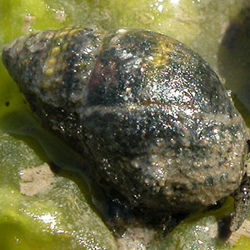 Ilyanassa obsoleta
Ilyanassa obsoleta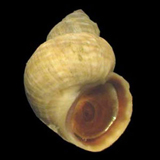 Littorina saxatilis
Littorina saxatilis 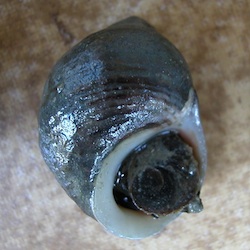 Littorina littorea
Littorina littorea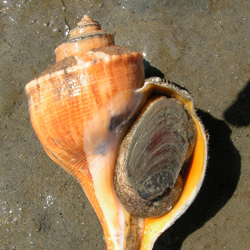 Busycotypus canaliculatus
Busycotypus canaliculatus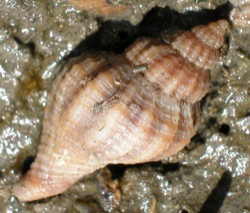 Urosalpinx cinerea
Urosalpinx cinerea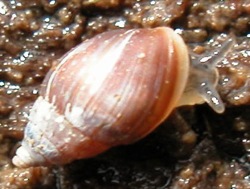 Myosotella myosotis
Myosotella myosotis 